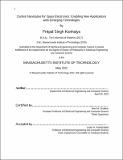Carbon Nanotubes for Space Electronics: Enabling New Applications with Emerging Technologies
Author(s)
Kanhaiya, Pritpal Singh
DownloadThesis PDF (3.814Mb)
Advisor
Shulaker, Max M.
Terms of use
Metadata
Show full item recordAbstract
Physical scaling of silicon-based field-effect transistors (FETs) yield diminishing returns while also becoming increasingly challenging. This has motivated the search for beyond-silicon technologies based on materials such as carbon nanotubes (CNTs) and transition metal dichalcogenides (TMDs). However, solely relying on new materials alone is insufficient to realize next-generation electronics. Therefore, we must coordinate advances across the entire computing stack whereby we leverage new materials and device architectures, to enable new circuits and systems, to ultimately realize new exciting applications. In this thesis, as a case study we use CNT-based electronics, a promising technology projected to provide orders of magnitude energy-delay-product (EDP) improvement versus conventional silicon-based digital VLSI systems. I experimentally demonstrate new three-dimensional (3D) device and circuit architectures leveraging unique low temperature processing of CNTs, demonstrate the first CNT-based SRAM arrays, and realize new applications with CNT-based radiation tolerant electronics to drive future space missions.
Date issued
2022-05Department
Massachusetts Institute of Technology. Department of Electrical Engineering and Computer SciencePublisher
Massachusetts Institute of Technology